A Healthy Market for Connectors
As electronics enable a new generation of portable medical devices, opportunities are increasing for manufacturers of these unique connectors and sensors.

Connectors and Sensors for the Medical Market
In addition to the universe of general-purpose connectors, more specialized interfaces fill important niches. These connectors are designed with specific features that satisfy the unique requirements of applications in automotive, aerospace, nuclear, power transmission, and heavy transportation. One of these categories includes connectors used in medical equipment, with a potential growth subcategory of wearable medical and fitness devices.
Sharply increasing medical costs incurred in hospital settings and clinics are driving demand for lower- cost and more convenient real-time data collection options for at-home health care. The ability to track one’s own vital signs or medical condition empowers the individual to make better health decisions.
It has been a long time coming, but it appears that medical as well as fitness devices have begun to penetrate the consumer market as people becomes more health- and diet-conscious.
The internet of things (IoT) is an enabling technology that will allow consumer monitors and fitness trackers to record and report multiple parameters. Many of these devices are now mass-marketed and are becoming classic consumer products.
Wearable electronic devices span a range from simple monitoring to precision biometric measurement, recording, and transmission devices. They are one aspect of the ongoing trend toward ubiquitous computing.
Wearable electronic devices are evolving into eight general application categories:
Medical: Vital-signs monitoring, therapeutic devices
Security: Automated personal identification for home, office, automobile access
Wellness: Track stress, weight, blood pressure, diet management
Fitness: Performance, heart rate, virtual coaching, goal management
Lifestyle Computing: Gaming, time management, data access
Communications: Voice, text, social media
Mood and Environment: Integrated lights, changing patterns, emotion tracking/display
Entertainment: Music, radio, streaming media
Advanced battery chemistry that can power a device for days is enabling a universe of new sensors and wireless connectivity via Bluetooth and Wi-Fi. The smart phone and a burgeoning list of highly specialized apps have made it a central device in this revolution, with the ability to measure and monitor an increasing list of medical parameters, including:
- Heart rate
- Blood pressure
- Diagnose ear infections
- Track heart rhythms
- Electrocardiograms
- Blood oxygen levels
- Measure glucose levels
- Measure liver, kidney, and thyroid function
- Degree of impairment due to alcohol or marijuana
Remote patient monitoring is expected to not only save money, but increase the ability to identify abnormal conditions at an earlier and more treatable stage. Wearable monitoring devices connected to the internet allow 24/7 tracking of sugar levels, cardiac rhythm, sleep patterns, as well as respiration rates. Data is instantly available to a doctor for analysis.
Smart watches and fitness bands are only the first wave of monitoring devices that will eventually replace the snapshot of data that a blood draw at a clinic provides today. The market for wearable electronics, such as the Fitbit activity tracker, has already begun to allow consumers to track their biometrics, including data such as pulse rate, blood pressure, and sleep patterns. New devices entering the market will provide much more useful information. Sensors embedded in clothing will utilize galvanic skin response to accurately predict cardiovascular performance.
![]() Today’s fitness monitors are capable of tracking calories burned, respiration and heart rates, distance traveled, steps taken, as well as local UV exposure rates. More importantly, some of these devices can measure the effect exercise has on the body and provide a highly customized exercise program. Blood oxygen levels can now be wirelessly transmitted to a smart phone. Even more sophisticated medical diagnostic devices are already in the pipeline.
Today’s fitness monitors are capable of tracking calories burned, respiration and heart rates, distance traveled, steps taken, as well as local UV exposure rates. More importantly, some of these devices can measure the effect exercise has on the body and provide a highly customized exercise program. Blood oxygen levels can now be wirelessly transmitted to a smart phone. Even more sophisticated medical diagnostic devices are already in the pipeline.
Another class of personal medical devices is designed to actually treat specific conditions ranging from hair loss to sleep apnea.
Philips launched an iPhone-controlled device designed to help suppress persistent pain. The PulseRelief uses Transcutaneous Electronic Nerve Stimulation (TENS) technology, which delivers electric pulses directly to nerves to prevent pain signals from reaching the brain.
New “lab-on-a-chip” sensors now in development will be capable of real-time blood analysis, which will be uploaded for predictive analysis. Alerts sent to doctors will be based on the urgency of the results. Doctors will be able to instantly share the resulting data and consult with specialists located anywhere in the world. The next step will utilize artificial intelligence to recognize a dangerous condition or pattern, predict an imminent medical emergency, and generate alerts to the doctor as well as EMT services.
The number of new and proposed electronic wearable products is growing rapidly.
A film-based sensor now in development can be applied directly to the skin to detect glucose levels. Temporary “smart tattoos” can track blood alcohol levels.
The market for wearable electronic devices is in a very early investigative stage as the industry searches for new applications that bring real value and will invigorate and propel the technology.
The challenge for manufacturers of electronic connectors will be to develop interconnects that can be reliably mated with non-traditional materials. Many of the medical and fitness sensors now on the market or in development are based on film substrates that include a variety of elastomers.
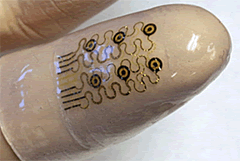
Maintaining a reliable electronic connection to metalized contacts on these thin flexible materials may require a new design approach.
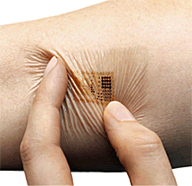
Small centerline interconnects must be nearly undetectable to the wearer even as skin and environmental conditions change.
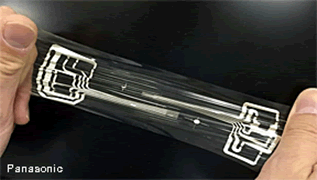
Panasonic introduced stretchy resin circuits that feature transparent electrodes fabricated from carbon nanotubes. These circuits can be stretched up to 2.5 times its relaxed length while maintaining electrical continuity.
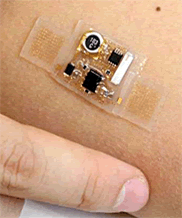
Some devices will be totally self-contained, with power supply, sensors, analysis chip, and Bluetooth transmitter integrated into a single patch. Many sensors today are based on microelectromechanical technology that features high density interconnects.
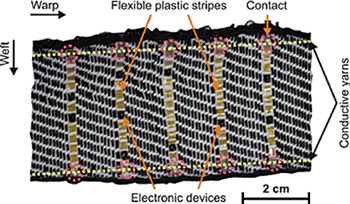 In addition to film-based sensors, progress is being made in the development of “smart textiles” that feature integrated electronic components.
In addition to film-based sensors, progress is being made in the development of “smart textiles” that feature integrated electronic components.
Fabric materials are often located in closes proximity to the skin, making them the ideal location for attachment of biometric sensors and environmental control elements.
Researchers are working on a “wired” bandage that could release measured doses of medication controlled by a smartphone. The bandage is made from electrically conductive fibers that are coated with a gel. When activated by the smartphone, the gel releases a precise dose of medication.
 Researchers at Georgia Tech are developing a woven fabric that can harvest energy from light as well as movement, potentially eliminating the need for a battery. A team at the University of California at San Diego was able to power a Bluetooth radio using lactic acid in sweat.
Researchers at Georgia Tech are developing a woven fabric that can harvest energy from light as well as movement, potentially eliminating the need for a battery. A team at the University of California at San Diego was able to power a Bluetooth radio using lactic acid in sweat.
Most smart fabrics today consist of conductive wires woven into the material, but introduce severe limitations on design and performance.
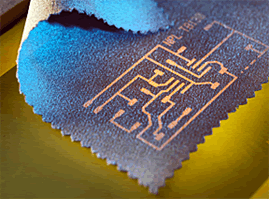 More recently, materials have been developed that allow printing conductive circuits directly on conventional fabrics. Theoretically, circuitry could be printed on finished garments, greatly expanding potential applications while reducing cost. RFID transponders and Wi-Fi antennas could proliferate.
More recently, materials have been developed that allow printing conductive circuits directly on conventional fabrics. Theoretically, circuitry could be printed on finished garments, greatly expanding potential applications while reducing cost. RFID transponders and Wi-Fi antennas could proliferate.
Even more exotic conductive materials are in development. Researchers at the University of Massachusetts were able to produce conductive microbial nanowires that are 60,000 times smaller than a human hair. Designing connectors for that scale will be a challenge.
Developing reliable and low-cost interconnect systems that mate to flexible and fabric circuits is no easy task. Connection to extremely small centerline, non-traditional materials may require entirely new interfaces. They must be capable of surviving multiple wash or dry-cleaning cycles, extreme temperatures, moisture, as well as constant flexing. Many consumer applications will be self-contained with no need for separable interconnects. However, medical monitoring, diagnostic, and therapeutic wearables will likely demand a much higher level of reliability, repairability, and performance. This is the electronic wearables segment that is most likely to provide the best opportunities for manufacturers of these unique connectors and sensors.
- Digital Lighting Enhances your Theatrical Experience - March 5, 2024
- DesignCon 2024 in Review - February 13, 2024
- Chip Technology Struggles to Keep Pace with Moore’s Law - January 30, 2024





